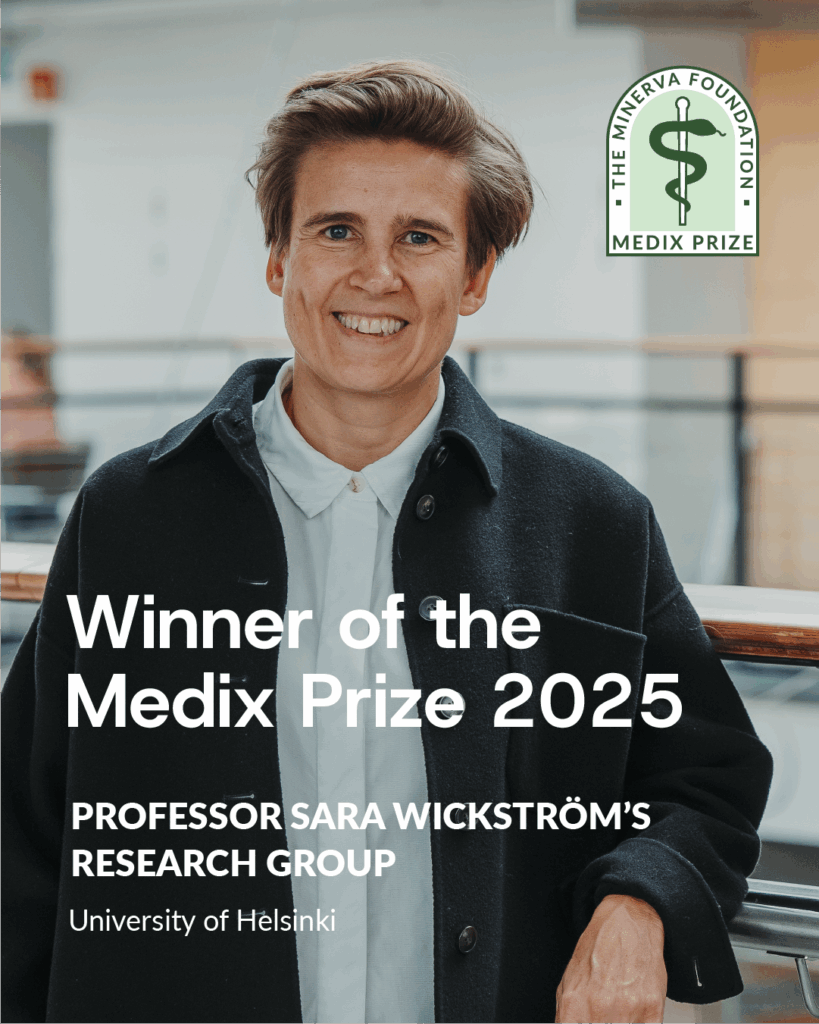Finnish research achieves breakthrough in cancer diagnostics – awarded the 2025 Medix Prize

Photo: Miikka Tikka
The 2025 Minerva Foundation’s Medix Prize has been awarded to Professor Sara Wickström’s research group at the University of Helsinki. The prize is awarded annually to Finnish research in biomedical or clinical medicine that has been published in an international peer-reviewed scientific journal.
In the award-winning article, researchers at the University of Helsinki used an AI-powered imaging analysis method to study hundreds of biobank patient samples at single-cell resolution. The work was carried out in collaboration with researchers from the University of Turku and the Max Planck Institute in Münster, Germany.
Recognition for long-term research work
Sara Wickström emphasizes that research is often a long-term effort spanning many years, which makes this recognition especially meaningful.
– It is wonderful that the members of the research group receive such a concrete acknowledgment of their work, says Research Director Sara Wickström.
– I am inspired by creating new knowledge and by understanding how the body and the environment work together. It is rare in research to discover something that can have an immediate benefit for patients. The possibility of improving people’s quality of life brings extra motivation and makes the work especially rewarding, Wickström says.
Decoding the complexity of cancer behavior at the cellular scale
The research team’s article offers a new perspective on the diagnosis of head and neck cancers, specifically squamous cell carcinomas. This cancer type ranks among the ten most common worldwide, with 700–900 new cases diagnosed annually in Finland.
Cancer tumors often consist of heterogeneous cell populations that behave in different ways, potentially making the disease aggressive and resistant to treatment. Wickström’s team succeeded in combining artificial intelligence and machine learning with spatial biology methods to study tissue architecture. Using this approach, the researchers analyzed hundreds of biobank patient samples at single-cell resolution and created a kind of “fingerprint” for each patient, enabling the assessment of cancer prognosis and treatment response.
This breakthrough narrows a significant knowledge gap: it helps to understand how the diversity of cancer cells influences disease progression and offers patients new opportunities for more precise diagnostics and personalized treatment.
– The method we have developed makes it possible to analyze individual cells both in cancer tissue and in the surrounding healthy tissue. We are able to identify which combinations of cells drive aggressive cancer and which predict a more favorable disease course, Wickström summarizes.
International recognition and scientific acknowledgment
Following its publication in autumn 2024, the study attracted attention both in the Finnish media and within the international cancer research community. It was reported by outlets such as ScienceDaily, and it was highlighted by the European Association of Cancer Research as a “Highlight in Cancer Research”.
The research is an excellent example of how basic and clinical research can converge. Behind it is a broad network of scientists combining expertise in bioinformatics, artificial intelligence, pathology, and clinical oncology.
– From the very beginning, the research has been basic science, not classically applied. Now, however, it has given rise to a spinout company that already employs four people and brings the results closer to patient care. This is a great example of how long-term research can also lead to practical applications, Wickström explains.
Innovation in cancer diagnostics – from research to spinout company
The research group has not stopped at scientific findings alone. Patent applications have been filed for the technology, and the discovery has led to the founding of the spinout company MultivisionDx, which aims to bring the method into clinical use.
The new analysis method and platform makes it possible to study millions of cells in patient samples with subcellular precision – providing a way to identify aggressive disease forms already at an early stage. The company’s goal is to develop a diagnostic tool suitable for clinical practice, one that can accelerate care pathways and improve treatment outcomes.
– The company’s ambitious goal is to have a fully developed software in use within 4–5 years, capable of automatically analyzing cancer samples. The aim is for a preliminary version to be available to other researchers as early as 2026, Wickström says.
Recognition for Finnish medical science
The Medix Prize, valued at 20,000 euros, founded by the Minerva Foundation, has been awarded annually since 1988 and is one of the most significant recognitions in Finnish medical science. The award to Wickström’s group underlines that research conducted in Finland is not only of the highest scientific quality but also internationally pioneering.
The justification for the winning article states that the study narrows a significant knowledge gap in understanding the mechanisms underlying cancer heterogeneity. For a long time, cancer research has faced two unresolved key questions: what cellular mechanisms explain the aggressiveness of heterogeneous tumors, and how heterogeneity can be reliably quantified to support diagnosis and prognosis.
The award-winning study was published in the fall of 2024 in Cell under the title “Multiparameter imaging reveals clinically relevant cancer cell-stroma interaction dynamics in head and neck cancer.” The authors are Karolina Punovuori, Fabien Bertillot, Yekaterina A. Miroshnikova, Mirjam I Binner , Satu-Marja Myllymäki , Gautier Follain , Kai Kruse , Johannes Routila , Teemu Huusko , Teijo Pellinen , Jaana Hagström , Noemi Kedei , Sami Ventelä , Antti Mäkitie, Johanna Ivaska and the Research Director Sara A. Wickström.

